As part of the European LIFE Lynxconnect project, a team of researchers from the University of Córdoba is studying the molecular basis of communication in Iberian lynxes through scent-marking —an aspect of their physiology that had not been studied before and that could prove useful in improving connections between natural populations of this emblematic species.
The conservation of the Iberian lynx continues to progress, bringing new hope for a species that was once on the brink of extinction and is still considered vulnerable. In the Iberian Peninsula, the overall population reached 2,401 individuals in 2024, of which 1,557 were adults or subadults (including 470 breeding females). This is a considerable achievement if we bear in mind that in 2002 fewer than 100 individuals remained. However, it still falls short of the ultimate goal: achieving a favorable conservation status with 750 breeding females by 2040.
Most current populations are located in different nuclei, some of which are isolated from each other. This fragmentation poses a risk to the genetic diversity of the species, which is among the lowest ever reported in any species.
“This is one of the main challenges for the conservation of the species today,” explains Guadalupe Gómez Baena, who is participating in the project and is a researcher at the Department of Biochemistry and Molecular Biology at UCO.
In response to this challenge, an international consortium made up of 22 partners from Spain and Portugal is working to achieve a metapopulation integration that will ensure gene flow among all Iberian lynx populations, so that the species becomes self-sustaining and genetically viable in the long term.
As part of the project, the UCO research group is studying an innovative aspect: the molecular basis of interspecies communication.
The team has already made significant progress in the molecular characterization of Iberian lynx urine and is currently testing the effectiveness of different formulations to build “olfactory pathways” that could guide individuals between the different population nuclei.
“Our research builds on my experience studying chemical communication in rodents,” explains Gómez Baena. “I studied how to harness the chemical signals that rats and mice naturally use in order to optimize pest control programs,” she adds.
Connecting existing nuclei and creating new ones: the key to Iberian lynx survival
The project, which covers a wide area in the central and southern Iberian Peninsula, includes actions in existing populations, the connection areas between them, and two new reintroduction zones: Sierra Arana in Granada and Altos de Lorca in Murcia.
One of the key strategies is the creation of connection areas with “stepping stones,” that is, small habitat patches that act as bridges or intermediate zones between large population nuclei. These areas significantly improve connectivity and, therefore, foster genetic flow among different populations.
The project also includes other measures such as the release of captive-bred lynxes, the elimination of roadkill black spots, the implementation of measures to reduce poaching, and the development of a health monitoring program to prevent disease outbreaks.
The project further has a strong outreach and communication component, including a teacher training program, exchanges between teenagers from rural and urban areas, and the production of 20 podcasts on different aspects of the Iberian lynx.
Another strength of the project lies in its transnational and participatory character. The consortium includes environmental authorities—with jurisdiction over roads in two countries and four autonomous communities—non-governmental organizations such as Adenex, WWF-Spain, and Fundación CBD-Hábitat, representatives of the hunting sector such as Fundación Artemisam, and private companies. It also has the scientific support of the CSIC-Doñana Biological Station.
If the planned objectives are achieved, the project—which is already the fourth LIFE initiative approved by the European Commission for the conservation of the Iberian lynx—will have made a decisive contribution to the recovery of the global Iberian lynx population.
This report is included in the activities carried out in the project "Desarrollo de redes de asesoramiento y gestión de proyectos europeos I+D+i en la UCO" with acronym "DevelOPE", within the framework of grant GPE2023-001243-P financed by MICIU/AEI/10.13039/50110001103.


